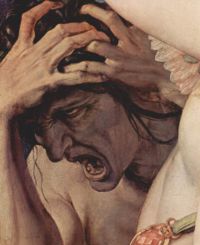Saturday, August 1, 2009
Smoke
Unlit, orange and white, pencil-thin and three inches long, you watch as it is twirled on fingers with nails dirty and yellow. Your eyes travel to the arm, its prickly skin and little scars, focus on a red welt just above the elbow. Then you turn the other way when you see the drying gash on the thin, bare shoulder.
You are sitting in a jeep caught in the afternoon traffic. The man beside you reeks of the day’s work. Two women in front gasp, giggle and whisper. They pout their painted lips. An old man in the far corner sleeps even as music blares from the dashboard. A squat man in his thirties has on huge black headphones; the office woman beside him worries her cuticles. Coins rattle almost imperceptibly, the engine is idling, the heat threatens to suffocate. You look back at the seven-year old boy holding the cigarette.
He is in faded blue with the sleeves ripped off, his shorts brown and two inches too short. You see the spindly legs, the knobby knees, the feet caked with dirt. He sits nonchalantly on the curb. You see there are others around him, older but no better off. He twirls and twirls the cigarette until someone throws him a light. The match flares and smolders, the tip is lit. He takes a long slow drag.
You imagine his lungs shriveling into black pulps, his breath turning acrid, his teeth—are all of them even permanent?—becoming frighteningly yellow. You recall that cigarettes have 4,000 chemicals and 43 of them cause cancer. You try to remember the statistics of people who die from it. A film clip of dying lung cells plays in the corner of your mind. You wonder who gave him his first cigarette. Father? Mother? Brother? Sister? Stranger? You imagine him trying to quit, hands shaking, lids fluttering, until he cannot resist the pungent temptation. How young will he be then?
The word carbon monoxide flashes in red neon, then twirls itself into death, death, death. You imagine his eyes, veined and hopelessly worn in a future you are not sure he has, his lips cracked, fingers tar-yellow, hair brittle, as he coughs up blood.
You imagine the poison pulsing through his veins, hypnotizing his fledgling heart into submission.
He exhales, the traffic stirs. Your jeep drives away from the boy whose childhood is being stolen by a pencil-thin stick three inches short. And you do nothing but stare at the smoke.
You are sitting in a jeep caught in the afternoon traffic. The man beside you reeks of the day’s work. Two women in front gasp, giggle and whisper. They pout their painted lips. An old man in the far corner sleeps even as music blares from the dashboard. A squat man in his thirties has on huge black headphones; the office woman beside him worries her cuticles. Coins rattle almost imperceptibly, the engine is idling, the heat threatens to suffocate. You look back at the seven-year old boy holding the cigarette.
He is in faded blue with the sleeves ripped off, his shorts brown and two inches too short. You see the spindly legs, the knobby knees, the feet caked with dirt. He sits nonchalantly on the curb. You see there are others around him, older but no better off. He twirls and twirls the cigarette until someone throws him a light. The match flares and smolders, the tip is lit. He takes a long slow drag.
You imagine his lungs shriveling into black pulps, his breath turning acrid, his teeth—are all of them even permanent?—becoming frighteningly yellow. You recall that cigarettes have 4,000 chemicals and 43 of them cause cancer. You try to remember the statistics of people who die from it. A film clip of dying lung cells plays in the corner of your mind. You wonder who gave him his first cigarette. Father? Mother? Brother? Sister? Stranger? You imagine him trying to quit, hands shaking, lids fluttering, until he cannot resist the pungent temptation. How young will he be then?
The word carbon monoxide flashes in red neon, then twirls itself into death, death, death. You imagine his eyes, veined and hopelessly worn in a future you are not sure he has, his lips cracked, fingers tar-yellow, hair brittle, as he coughs up blood.
You imagine the poison pulsing through his veins, hypnotizing his fledgling heart into submission.
He exhales, the traffic stirs. Your jeep drives away from the boy whose childhood is being stolen by a pencil-thin stick three inches short. And you do nothing but stare at the smoke.
Subscribe to:
Post Comments (Atom)














This was very well-written. You used the second-person POV effectively. The vivid imagery contributes to the pathos of this story. In an economy of words, you managed to portray a lot of emotion. The story was wonderful. This material works, beginning to end. :) GREAT JOB!
ReplyDeleteMICO.
ReplyDelete*flattened* wait i mean *flattered*
haha.
THAAAAAAAAAAANKS!!! :)
You sort of channeled Italo Calvino in "If On A Winter's Night A Traveler." This is very well-written, really, especially, considering that it is very challenging to write in the second person POV.
ReplyDeleteBy the way, you're welcome. :)
i remember this one. you showed it to me about a few minutes before i had my chem16 first long exam. cool dearie. this is wonderful.
ReplyDelete